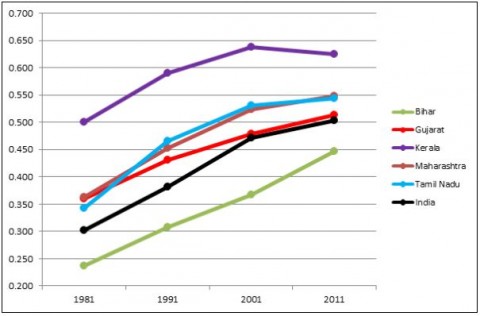In a recent post for Ideas For India, Maitreesh Ghatak and Sanchari Roy analyse the economic performance of 16 major Indian states over the past three decades. In this excerpt, they investigate whether Gujarat outperformed other states in terms of economic development in the 2000s under Narendra Modi’s leadership. Click here for the complete post.
India’s national elections, it seems, will be fought mainly on issues of governance and economic performance. To the extent there is a focus on the personalities involved, such as Narendra Modi or Rahul Gandhi or Arvind Kejriwal or potential “Third Front” candidates, such as Nitish Kumar or Mamata Banerjee, most of the discussion is about their economic track record or lack thereof. This is a welcome development. However, in the grand theatre of Indian politics, facts often take a back seat to slogans, and opinions get sharply polarised. For example, we either hear that Gujarat’s economic performance has been nothing short of miraculous due to the magic touch of Modi or that Gujarat’s so-called growth story is all hype and a public relations campaign aimed at covering up a dark underbelly of poverty, inequality, and low levels of human development indicators.
 Human Development Index scores of selected states, by decade. Source: Ideas For India
Human Development Index scores of selected states, by decade. Source: Ideas For India
A lot of this debate reflects disagreements about two sets of issues. First, there are many dimensions of economic performance – level of per capita income, growth rate of per capita income, Human Development Index (HDI) that put weight on not only income but also on non-income measures (for example, education and health), level of inequality, percentage of people below the poverty line, and many others. Which index we choose to emphasise reflects either our preferences as to the aspect of economic performance we value the most, or our views as to which dimension has to be improved (say, per capita income) for bettering the dimension we care about (say, poverty alleviation). Second, even if we focus on one particular dimension of economic performance, how do we attribute changes in this dimension to the role of a specific leader?
If we simply look at the figures, four facts will jump out: first, Bihar has improved the most in the 2000s, even though it has been at the bottom of the list for all indicators and still has a fair distance to go before it can climb above the national average; second, Kerala has far outpaced other states in terms of the HDI all through; third, Rajasthan was the star-performer in terms of reducing inequality; and fourth, Maharashtra and Gujarat have consistently been top performers in terms of per capita income and its growth, with Haryana and Tamil Nadu deserving mention on this count as well. All these achievements are noteworthy, but it is hard to single out any state as the top performer in the 2000s.
To the extent this assessment goes against the view held by many people, independent of their political leanings, that Gujarat has done spectacularly well under Modi, the explanation lies in the method that we have used to examine available data, namely, the difference in difference approach.
In particular, this is what we tried to figure out: did a state that has for a long time been one of the most developed states in terms of per capita income, and was already improving at a rate higher than the rest of the country, accelerate further and significantly increase its lead under Modi’s stewardship? Our analysis shows that this did not happen. Both Maharashtra and Gujarat improved upon an already impressive growth trajectory in the 2000s, but the margin of improvement was too small to be statistically meaningful. So while Gujarat’s overall record is undoubtedly very good all through the last three decades, its performance in the 2000s does not seem to justify the wild euphoria and exuberant optimism about Modi’s economic leadership.
Of course, it is possible that there are trends that this evidence cannot capture. Maybe with a longer time horizon, the effects of some of Modi’s policies will show up in the evidence, although given that he is now in his fourth consecutive term of power, this argument is not very strong. It is also possible that if Modi comes to power at the centre, he may well achieve a turnaround of the Indian economy due to his governance style. All that is possible in theory, but the existing evidence is insufficient to support these views.
Read the complete post on Indian states’ economic performance on Ideas For India.








3 Comments